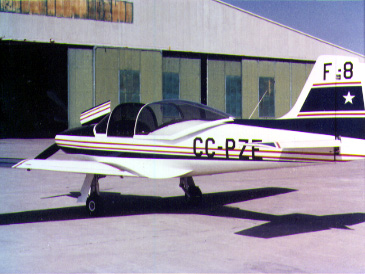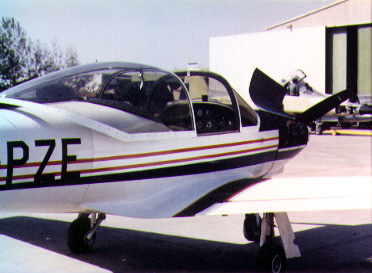First Flight:
Chilean Air Force
![]()
First Flight:
|
|
by Alfred Scott
This article appeared in the September 1985 issue of the Falco Builders Letter. |

While at Oshkosh, we received a call in Richmond from Santiago, Chile, advising us that the Chilean Air Force had recently flown their Falco. I have no information other than that and am hoping for additional information.
The Chilean Air Force began work on the Falco in June 1981. They wanted everything right away, and I-grossly underestimating the amount of work left to do-thought I could do it all in short order. It was then that I adopted the work schedule of nights-and-weekends that still goes on.
The Falco was built by a small team of men working under Capt. Bragheto at the Il Bosque base near Santiago. The project had a number of interruptions. The delay in shipping many of our kits caused part of this. The other delay was caused by the loss of a number of kits in shipment. The Chilean Air Force has a highly computerized procurement system which requires a requisition number and purchase order number. Unfortunately, the original purchase order was not given a number, so the system broke down and shipped parts did not have the paperwork to automatically tell the clerks where to ship the parts. Fortunately, the lost parts were eventually discovered in a warehouse in Washington.
The Chileans have a long history of aviation innovations, almost all of which escape the notice of us in the U.S. (We seem to have an extreme case of tunnel-vision; after all, how many of you had heard of the Falco before we started to sell the design?) The Chileans, for example, were the first to convert the old radial engine Sikorsky helicopters to turbine engines.
Like all countries, Chile is interested in developing its own aviation industry. Many countries have tried this, with varied success. The least successful have been indigenous designs, which usually result in average airplanes designed and produced at enormous cost. The Finnish Valmet Leko trainer, for example, is a fixed gear 200 hp trainer that is vastly inferior to the Falco yet costs the government of Finland $365,000.00 per aircraft. For the price of the Falco plans, the Chilean Air Force got an unheard-of low cost for the design, bettered only by the Taiwanese who never paid Pazmany for his plans.
The most successful program has been in Brazil, and the government-funded-but-now-private-and-profitable Embraer built Piper aircraft from kits supplied from the U.S. Chile has adopted the same strategy, license building from kits four aircraft. These are the Pillan trainer (a tandem design made mainly from Piper components), the Falco and two designs from CASA in Spain. Of these, the Falco is easily the least expensive, and at the time the project was begun, it was envisioned that the Falco would be used as an acrobatic trainer and for sale to the Chilean Aero Clubs. I am hopeful that the Chilean Air Force will build additional Falcos, a decision I don't expect to be made soon. I suspect that the Falco will undergo an extensive evaluation by all potential users of the aircraft.
